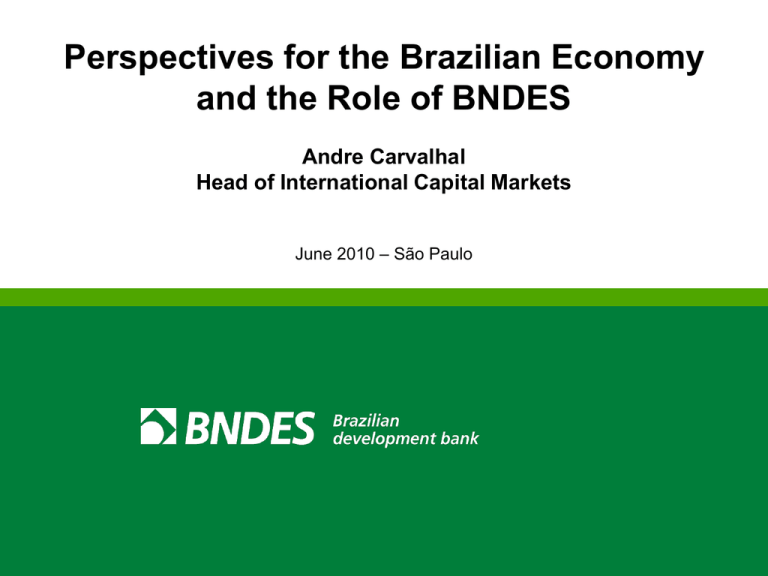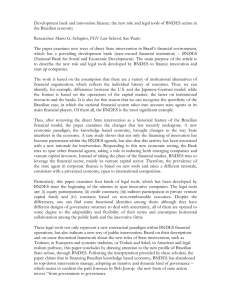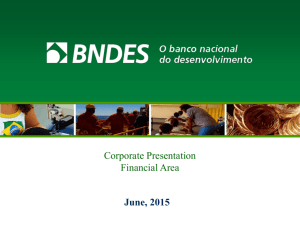BNDES Highlights
advertisement

Perspectives for the Brazilian Economy and the Role of BNDES Andre Carvalhal Head of International Capital Markets June 2010 – São Paulo BNDES Highlights Founded on June 20th, 1952 100% state-owned company Key instrument for implementation of Federal Government’s industrial and infrastructure policies Support to micro, small and medium-sized companies Main provider of long-term financing in Brazil Emphasis on financing investment projects EXIM activities Equity investor through BNDESPAR Group Structure As of Dec 31, 2009 Consolidated Assets R$ 386.6 billion US$ 222.0 billion BNDES Finances long-term investments BNDESPAR FINAME BNDES Limited Equity Participation Finances capital goods production and purchases Internationalization of Brazilian companies Main Instruments Financing of: • Complete business projects • Export of goods and services • Machinery and equipment Equity Investment • Stocks and debentures • Venture Capital • Seed Capital Funds • Private Equity Funds BNDES vs. Multilateral Banks US$ millon Total Assets BNDES IBRD 31/12/2009 222,050 84,006 275,420 15,887 15,867 20,674 40,037 5,287 3,868 794 3,114 235 71,589 11,424 18,564 5,292 162,917 58,049 105,698 11,687 Net Income Loan Disbursements 30/06/2009* CAF 31/12/2009 Shareholders' Equity Total Loans IDB 31/12/2009 Capitalization 7.1% 24.6% 14.5% 32.9% ROA 2.3% 1.0% 2.4% 2.4% ROE 25.0% 4.0% 8.0% 6.2% 1952 1959 1945 1968 Founded IDB = Inter-American Development Bank IBRD = The International Bank for Reconstruction and Development (World Bank) (*) Unlike other institutions, 12-month fiscal year ends June 30th CAF = Corporación Andina de Fomento Capitalization = Shareholders’ Equity / Total Assets ROA = Return On average Assets ROE = Return On average Equity Perspectives for the Brazilian Economy The Brazilian economy can grow much faster than the average in developed countries Investments will be driven by four main sectors: oil & gas, electric power, logistics and housing Opportunities for intensive strategies in innovation and social and environmental sustainability Main challenges: increase aggregate investment/GDP rate, and boost competitive progress in the manufacturing industry GDP may grow 5% p.a. in the 2010-2014 period GDP: Annual Real Variation (%) 6.5 5.5 4.5 3.5 2.5 1.5 0.5 -0.5 5.7 6.1 5.1 5.0 4.0 2.8 3.2 2.5 -0.2 Average Average 1984-93 1994-03 2004 2005 2006 2007 2008 2009 Average 2010-14 * * 2009 and Avg 2010-14: BNDES' Forecasts. Sources: IBGE and BNDES. Source: IBGE. Investment has strong growth path Forecast of Investment Ratio 2009-2012 (% of GDP) 22,0 21,2 21,0 20,2 Forecast 20,0 19,0 17,4 18,0 17,0 18,6 18,7 16,4 16,7 16,0 15,0 2006 2007 2008 Source: BNDES. Elaborated by: APE/BNDES 2009 2010 2011 2012 BNDES was responsible for 37% of total credit increase since sep/08 BNDES Approvals and Disbursements1 (US$ billion) 85.2 90 Dis burs ements 80 A pprovals 66.3 70 60 50.6 68.8 88.2 71.5 50.5 50 34.1 40 30 20 19.3 10.9 13.1 22.3 33.1 23.5 13.6 12.9 10 0 2003 2004 2005 2006 2007 2008 2009 2010* *last 12 months up to January 2010 Source: BNDES. *considering the average exchange rate for each year Disbursements by Business Sector 7% 11% 30% 52% 2001 7% 8% 12% 14% 35% 30% 46% 48% 2002 2003 Industry Infrastructure 5% 17% 5% 7% 9% 7% 36% 2004 12% 14% 8% 6% 5% 39% 35% 40% 43% 46% 2007 2008 2009 33% 40% 38% 40% 12% 50% 53% 2005 2006 Farming and Cattle Raising Trade and Services 2009 Operations Number of Operations Disbursements 390,729 112,997 29% US$ 72 billion 23,711 6% 28,725 7% 225,296 58% individuals micro and small 45,558 64% 2,632 4% medium Petrobras 13,026 18% 547 1% 3,776 5% large 6,055 8% other Exchanged to US dollar on disbursement date Equity Investment Portfolio • Equity investments: evaluation uses lowest value among acquisition cost or market value • Market appreciation valued at US$ 53 billion as of Dec 31st, 2009 US$ million Stock Book Value Market Value Profit Eletrobrás 2,483 4,322 1,839 Vale 2,131 7,857 5,726 676 14,410 13,734 10,123 17,686 7,563 4,008 9,076 5,068 19,421 53,351 33,930 Petrobras Other listed companies Investment in unlisted companies * Total (*) estimated value based on projections of economic value Investment Outlook: Positive Prospects Sectors US$ billion 2005-8 2010-13 Growth (%) Infrastructure 111 152 6.5 Industry 191 271 7.2 Total 302 423 7.0 US$/R$ = 1.80 Source: BNDES Forecast Investments in Infrastructure were not affected by the crisis US$ billion Sectors Growth 2005-2008 2010-2013 % year Electric Power 38 51 6.4 Telecom 37 37 0.2 Sanitation 12 22 11.7 Railroads 9 16 13.2 Roads 23 33 7.8 Ports 5 14 22.9 Infra 111 Source: BNDES 152 6.5 Investment in Industry: Domestic-led sectors have already recovered from the crisis US$ billion Sectors Growth 2010-2013 171 % year Oil and Gas 2005-2008 112 Mining 29 25 (3.1) Steel 15 20 5.7 Petrochemical 5 17 28.9 Vehicles 12 17 7.3 Electronics 8 12 6.7 Pulp & Paper 10 10 0.5 Industry 191 271 7.3 Source: BNDES 8.8 Challenges for Infrastructure PAC (Growth Acceleration Program) 2014 World Cup 2016 World Olympics Pre-salt Environmentally sustainable projects PAC Program PAC Investments: 2007 - 2010 BRAZIL AGENDA US$ billion % of Share ENERGY: SOCIAL & URBAN: LOGISTICS: Focus on infrastructure: PAC (Growth Acceleration Program ) TOTAL 157.8 98.1 33.5 55 34 12 289.4 100.0 Source: Presidency of Republic (www.pac.gov.br) FX: 1.7412 (Dec.09) ENERGY Electric Energy - Generation - Transmission - Distribution Oil & Gas Renewable Energy LOGISTICS Highways Railroads Ports Airports Waterways Merchant Marine SOCIAL & URBAN Electricity for Everyone Sanitation Urbanization Subways Water Resources BNDES is an Important Supporter of PAC BNDES Portfolio in PAC US$ billion % of Share ENERGY: SOCIAL & URBAN: LOGISTICS: TOTAL 56.5 5.0 15.5 73.4 6.5 20.1 77.0 100.0 FX: 1.7306 (Apr.10) BNDES in PAC % of Share • 327 projects: 73.4 - Supported Projects: US$ 57.3 Bn 6.5 - Eligible Projects: US$ 13.1 Bn 20.1 • 17 Prospective Projects: US$ 6.7 Bn 100.0 Disbursements by Region SouthEast 20% CenterWest 5% Northeas t 24% Interregional 27% South 8% North 16% PAC 2 • US$ 883.3 billion in investments as of 2011: US$ 532.7 billion in the 2011-2014 period and US$ 350.9 billion after 2014: US$ 633.3 billion for energy US$ 60.5 billion in transport, including railways and the High-speed Train (TAV) Assorted social investments: US$ 10 billion in urban mobility US$ 12,8 billion in the Citizen’s Community program My House, My Life (MHML) goal of 2 million homes Other programs include A Better City, Water for Everyone and Electricity for Everyone US$/R$ = 1.80 2014 World Cup • For the 2014 World Cup, FIFA requires investments to the tune of US$ 6.4 billion • BNDES ProCopa Programs • Arenas Up to US$ 2.7 billion to build and remodel stadiums and urbanization investments in surrounding areas. • Tourism Up to US$ 556 million to build, remodel, expand and modernize hotels. US$/R$ = 1.80 2016 Olympics Brazil has a great opportunity to improve its urban infrastructure and generate employment Investment in: transport, urban mobility, hotels, tourism, communications, security, stadiums and electric energy: US$ 16 billion in investments in the Olympics will produce an impact US$ 56.8 billion by the end of 2027* All these investments will have relevant impacts on a wide array of production chains as well as on the expectations of the private sector. *government’s forecast US$/R$ = 1.80 Pre-salt Pre-salt - Great opportunity for Brazil: growing long-term demand for the complex goods and services supply industry Strategic goals for the goods and services supply industry: Competitive and sustainable expansion of its supply capacity Developing higher aggregate value segments Generating higher-skilled employment Maintaining the steady increase in local goods & services The BNDES will foster investments throughout the entire oil and gas production chain, aiming at building a competitive global supplier of goods and services in the Oil & Gas sector. Impacts from Petrobras investments on the production chain (2009-2013) US$ 111.6 bn in investments may generate industrial production of almost US$ 202.2 billion Machinery and Equipment Transport Equipment (especially Ship-building) Metals Other production sectors Trade Services Direct Effect 43.1 Total In US$ billion Indirect Effect Total 8.3 51.4 28.1 11.0 9.1 13.2 7.1 6.8 19.9 36.9 8.6 34.0 34.9 30.9 46.0 21.9 17.1 111.6 90.6 202.2 Total investments represent 22% of the pre-salt. Therefore, such impacts are still underestimated and have room for growth. Source: Petrobrás and IBGE. Elaborated: APE/BNDES US$/R$ = 1.80 Brazil’s Long Term Challenges Resume and qualify long-term planning (energy, logistics, environment, IT infrastructure, ...) Promote and stimulate domestic savings in order to provide long-term funds for investment (banks and capital market) Develop capacity for innovation and competitiveness in the manufacturing industry, and promote global presence of Brazilian companies (vs. significant challenge due to exchange rate appreciation) Increase opportunities for social mobility (job expansion, development/improvement in education) and reduction of the inequality in income distribution Promote innovation and development of renewable energy sources The Brazilian Government, specifically the BNDES, is committed to supporting investments, particularly in energy and infrastructure Thank you! Brazilian Development Bank - BNDES To contact us: www.bndes.gov.br/english/











